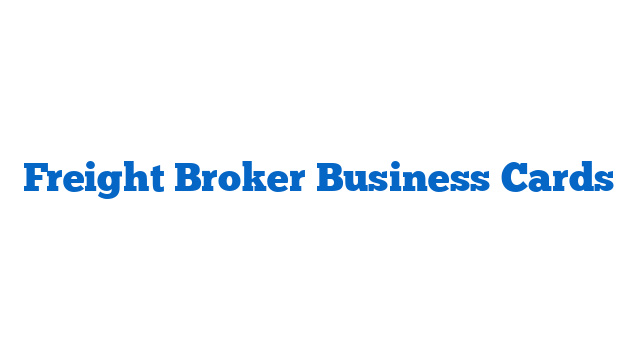
Freight Broker Business Cards: Enhancing Your Networking and Branding Efforts
If you’re involved in the freight broker industry, you understand the importance of effective networking and building strong business relationships. One powerful tool that can significantly boost your networking efforts is a well-designed and professionally printed freight broker business card. These compact pieces of marketing collateral not only provide essential contact information but also act as a powerful branding tool, leaving a lasting impression on potential clients and partners.
Why Are Freight Broker Business Cards Important?
1. Professionalism: A high-quality business card demonstrates professionalism and attention to detail, instilling confidence in potential clients and partners. It shows that you take your business seriously and are committed to maintaining a professional image.
2. Networking: Business cards are a convenient and tangible way to exchange contact information during networking events, conferences, and industry gatherings. They provide a quick and efficient means of establishing connections and potential collaborations.
3. Branding: A thoughtfully designed business card can effectively showcase your brand identity. By incorporating your company logo, colors, and a visually appealing layout, you can reinforce brand recognition and leave a memorable impression.
4. Accessibility: Unlike digital contacts stored in smartphones or email, business cards are always accessible. They don’t rely on internet connectivity or battery life, ensuring that your contact information is readily available to anyone who receives your card.
Design Elements for Effective Freight Broker Business Cards
1. Clear Contact Information: Make sure your business card includes your name, job title, company name, phone number, email address, and website URL. Ensure that the text is legible and easy to read.
2. Logo and Visuals: Incorporate your company logo and choose visuals that align with the freight broker industry. This will help reinforce your brand while providing a visual representation of your services.
3. Professional Typography: Select a font that is clear, professional, and easy to read. Avoid overly decorative or complex fonts that may hinder legibility.
4. Color Scheme: Choose colors that reflect your brand’s identity and create a visually appealing design. Consider the psychological impact of colors on the recipient and select combinations that convey trust, reliability, and professionalism.
5. Unique Layout: Stand out from the crowd by opting for a unique and innovative card layout. This will help make your card memorable and ensure it doesn’t get lost in a sea of traditional designs.
Printing and Paper Quality
Once you have the perfect design, it’s crucial to choose a reputable printing service that can bring your vision to life. Select a printing company that specializes in business card production and offers high-quality materials and finishes.
1. Paper Weight: Opt for a sturdy paper stock that is resistant to wear and tear. A thicker card stock will also leave a stronger impression on the recipient.
2. Finishes and Coatings: Consider adding finishes such as glossy or matte coatings to enhance the look and feel of your business cards. These finishes can make your card more durable and visually appealing.
3. Print Quantity: Analyze your networking needs and determine an appropriate quantity for printing. Ordering in bulk can save you money in the long run, ensuring you always have a sufficient supply on hand.
Conclusion
Freight broker business cards are an essential tool for any professional involved in the industry. They not only facilitate networking but also reinforce your brand identity and professionalism. By investing in a well-designed and professionally printed business card, you can leave a lasting impression on potential clients and partners, ultimately boosting your business success.
Frequently Asked Questions about Freight Broker Business Cards
1. Can I design my own freight broker business cards?
Yes, there are various online design tools and software available that allow you to create your own business card design. However, it is recommended to seek professional design services for a more polished and impactful result.
2. How should I distribute my business cards?
Take advantage of networking events, industry conferences, and trade shows to distribute your business cards. Additionally, consider leaving a stack of cards at relevant establishments or sharing them during client meetings.
3. Should I include social media handles on my business card?
It depends on your social media presence and strategy. If you actively use social media platforms for business purposes, including your handles can encourage recipients to connect with you on those platforms as well.
4. How often should I update my business card design?
Regularly evaluate your business card design to ensure it aligns with your current branding and industry trends. Aim to update your design every few years or whenever significant changes occur within your business.
5. Can I include additional information on the back of my business card?
Yes, the back of the business card provides additional space to highlight key services, a brief company description, or even a QR code linking to your website or portfolio. However, avoid cluttering the card and maintain a clean and organized layout.















Discussion about this post